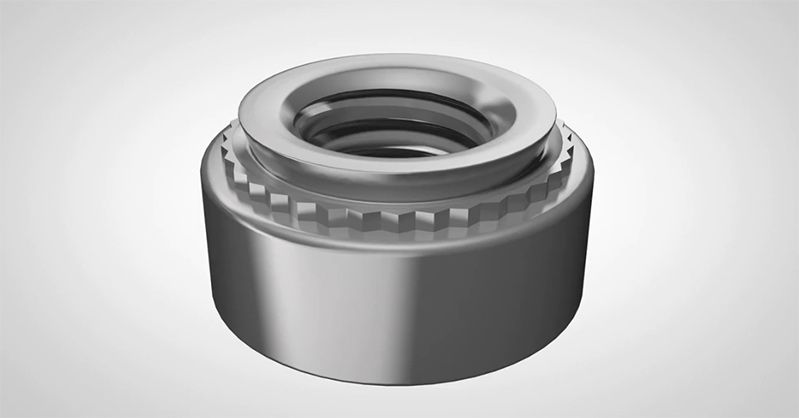Self-clinching fasteners have all-manner of applications from panel-mounting hardware to studs and nuts. Famous for their strength and cost savings, they are ideal for many fastening purposes. HTF offers various precision-made fasteners in standard types suitable for applications requiring high torque loads and low production cost.
What are Self-Clinching Fasteners?
Self-clinching fasteners are typically threaded devices that cause the thinner host metal to cold flow into the undercut of the fastener when pressed or threaded. Types of self-clinching fasteners include:
- Studs
- Nuts
- Spacers
- Access hardware
- Panel-mounting hardware
- Hooks
- Cable-tie mounts
Why Self-Clinch?
There are many reasons why self-clinching fasteners are the best choice, including their strength, versatility, performance, and cost savings. Self-clinching fasteners have stronger threads than tapped panels. No secondary operations are required when installing as they are installed directly into a plain round hole. Self-clinching fasteners have decreased installation cycle times and are in-die capable. Other benefits include environmental benefits and installation versatility. With self-clinching fasteners, the host metal does not have to be of the same metal as the fastener. The entire process of self-clinching fasteners increases environmental consciousness because there is no welding splatter and has lower energy requirements.
Advantages of Self-Clinching Fasteners
Self-clinching fasteners provide strength in their threads or attachment in metal as thin as 0.20mm/.008”. Their design produces high pushout and torque-out resistance while not requiring special hole preparation before installation. Self-clinching fasteners can be installed directly into a plain hole without the need for chamfering and deburring. The self-clinching fastener is installed using any parallel acting squeezing force and does not require re-tapping after application allowing installation costs to be kept low. Another benefit of self-tapping fasteners is having the reverse side of the metal sheet remain flush after installation. For high-volume applications, they can be installed using automated equipment.
These fasteners were designed for manufacture and assembly. The self-clinching fasteners aid designers in meeting DFMA parameters. These include:
- Fewer parts to handle
- Fewer assembly steps
- Less total assembly time
- Shorten time to market
Using self-clinching fasteners cuts down on hardware needed, such as washers, lock washers, and loose nuts. All of these parts become unnecessary for final assembly. Because there is less hardware to install, the number of steps in the installation process can be significantly reduced. Designers have the advantage of a decrease in overall assembly time with fewer assembly steps and parts. These lead to a shorter time until the design reaches the market with the benefit of improved quality, simplification, and reduced overhead.
Benefits of Self-Clinching vs. Welding
Let’s review the many benefits of self-clinching fasteners as they compare to welding. With self-clinching, there is an increased thread strength, which means a hardened clinch fastener. They can be installed into dissimilar metals as thin as 0.20mm and are flush on the opposite side. The clinch fasteners can be installed in-die, something that you cannot do with welding. Welding causes spatter and environmental concerns that are not an issue with self-clinching fasteners. With the fasteners, there is no introduction of thermal stresses. The installation process is faster, cleaner, and safer. The time to market is reduced drastically with less hardware needed and welding time cut out of the manufacturing process.
Process Cost Savings vs. Weld Fastener
Cost savings are always essential for designers, and self-clinching provides those savings far more significant than weld fasteners. There is a reduction in energy consumption of the installation process over that of weld fasteners. Self-clinching fasteners also add the benefit of a reduction in logistical costs. The panel and the fastener can be pre-finished, which aids in removing logistical and installation costs. With weld fasteners, you risk thread contamination and have a more significant environmental impact. Removing the introduction of thermal stress and weld spatter hugely beneficial in cost savings. The total installed cost savings is $0.13 per stud when using self-clinching fasteners over weld fasteners by removing the installation costs of welding.
Cost-Effective Installation Solutions for Medium Volume Applications
If welding is used, there will be an average increase in the cost of $4,638. The most effective way to eliminate that cost is by using the Haeger Robot or manual installation for medium and low volume applications. The benefits of self-clinching fasteners and the Haeger Robot include reducing the energy consumption of approximately 390 KWH per five million installations at a savings of $47. Maintenance costs are low at less than $1,200 per year to keep the robot in excellent working condition. The equipment has a ten-year lifetime and 99% uptime making it incredibly reliable. The Haeger Robot has 24/7 support, meaning production will not be slowed when adjustments are needed.
The Clear Choice
Self-clinching fasteners are the clear choice both for strength, durability, performance, and cost savings. Leave welding and its negative environmental impact and higher costs behind. Hi-Tech Fasteners are standing by to provide you with industry-leading, precision-made self-clinching fasteners of all kinds. As a result, it is possible to reduce the steps for installation and have a higher quality fastener promising lower cost and greater strength. In addition, HTF has you covered with standard self-clinching fasteners as the fattest shipping lead times.






.png?width=800&name=InventoryXpert-Blog-Alt%20(5).png)


